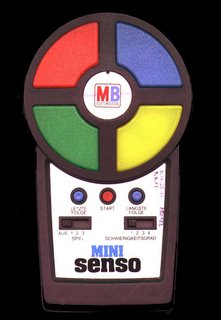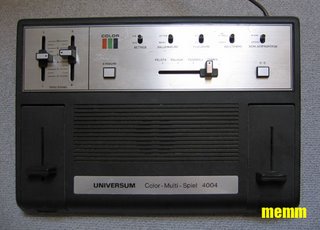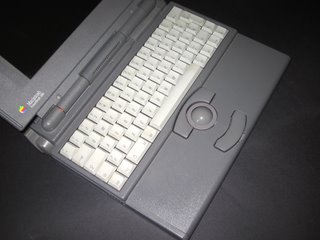Old fashioned man-machine interfaces
I recently made a research about old-fashioned
man-machine interface to investigate different kinds
of physical interaction using basic sensors:
sliders, dials etc.
I selected a few of them that could be suitable for
music navigation:

An old style slot-machine with the classic handlebar.

Heres a picture of the very famous, portable Mini Senso.
The Game is about pushing buttons in the right sequence, which is shown to you with increasing speed.



Pong, one of the first videogames was "invented" in 1972.
The aim of the game should be known by most people here: "Avoid missing ball for high score". The game is for two and every player has his paddle in his part of the screen, which he can move up and downwards. The ball of the game is always moving and the players have to block the ball so
that it cant reach their screenborder (that would be a goal for the other player). By blocking the ball it is also shot toward the goal of the contrahent.
In the first picture we have the Universum Multi-Spiel-Color A" (Spiel means game) where the paddle controller of the right player is build into the console.
The controller for the left player can be detached from the console and is wired to the rest of the machine with a very long cable.

The vectrex was always called "the king of videogames".
No other console before or after the Vectrex had a comparable configuration, and no other non-portable game console had a monitor of its own (integrated).

The genuine Atari CX 40 "Standard Joystick Controller".
The mother of all joysticks ( the cx40 was the first
joystick at all).

The Atari Driving Controller.
The "wheel" can be moved without being stopped at
the limits of both directions.

old Apple Powerbook (1994) spheric controller.

Belkin's Nostromo represents a collection of keys, a mouse wheel
and a directional pad cleverly baked into one unit.
Most of the old fashion games images come from: www.memm.de
man-machine interface to investigate different kinds
of physical interaction using basic sensors:
sliders, dials etc.
I selected a few of them that could be suitable for
music navigation:

An old style slot-machine with the classic handlebar.

Heres a picture of the very famous, portable Mini Senso.
The Game is about pushing buttons in the right sequence, which is shown to you with increasing speed.



Pong, one of the first videogames was "invented" in 1972.
The aim of the game should be known by most people here: "Avoid missing ball for high score". The game is for two and every player has his paddle in his part of the screen, which he can move up and downwards. The ball of the game is always moving and the players have to block the ball so
that it cant reach their screenborder (that would be a goal for the other player). By blocking the ball it is also shot toward the goal of the contrahent.
In the first picture we have the Universum Multi-Spiel-Color A" (Spiel means game) where the paddle controller of the right player is build into the console.
The controller for the left player can be detached from the console and is wired to the rest of the machine with a very long cable.

The vectrex was always called "the king of videogames".
No other console before or after the Vectrex had a comparable configuration, and no other non-portable game console had a monitor of its own (integrated).

The genuine Atari CX 40 "Standard Joystick Controller".
The mother of all joysticks ( the cx40 was the first
joystick at all).

The Atari Driving Controller.
The "wheel" can be moved without being stopped at
the limits of both directions.

old Apple Powerbook (1994) spheric controller.

Belkin's Nostromo represents a collection of keys, a mouse wheel
and a directional pad cleverly baked into one unit.
Most of the old fashion games images come from: www.memm.de


